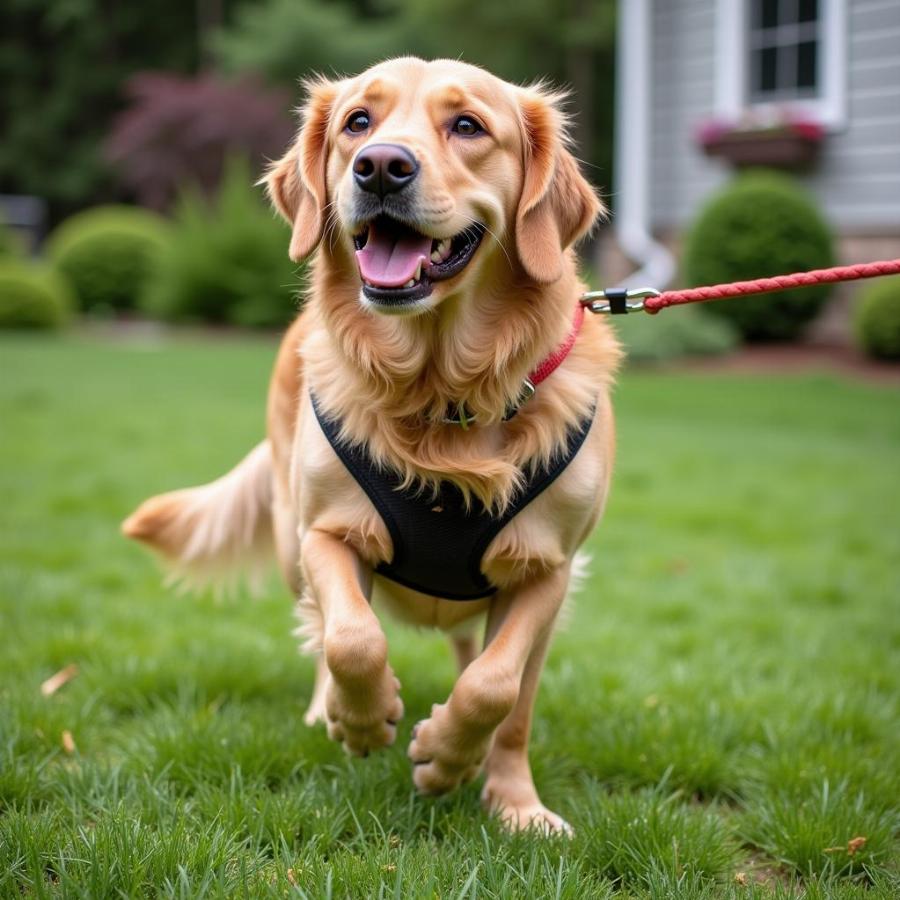A dog tie out is a device that allows you to give your furry friend some outdoor freedom while still keeping them safely contained. It typically consists of a cable, rope, or chain that attaches to your dog’s collar or harness at one end and a stationary object like a stake or a tree at the other. It’s important to understand that a tie out is not a substitute for a properly fenced yard but rather a temporary solution for supervised outdoor time.
Understanding When a Dog Tie Out is Appropriate
While a tie out might seem like a great way to give your dog some fresh air and exercise, it’s not suitable for every situation. Let’s examine when using a tie out can be a good idea and when it’s best to explore other options:
Suitable Situations:
- Camping trips: A tie out can be a safe way to let your dog hang out at your campsite.
- Picnics: Enjoying a meal outdoors? A tie out lets your dog join the fun without the risk of wandering off.
- Events: Outdoor events can be overwhelming for dogs. A tie out provides a sense of security in unfamiliar environments.
- Temporary housing: If you’re staying in a place without a fenced yard, a tie out can offer a temporary solution for potty breaks and fresh air.
Situations to Avoid Using a Tie Out:
- Unsupervised: Never leave your dog tied out unsupervised. They could get tangled, injured, or encounter other animals.
- Punishment: A tie out should never be used as a form of punishment.
- Long periods: Extended periods on a tie out can be stressful and frustrating for dogs.
- Aggressive dogs: Dogs prone to aggression towards people or other animals should not be restrained with a tie out.
 Dog Enjoying Fresh Air on a Tie Out
Dog Enjoying Fresh Air on a Tie Out
Choosing the Right Dog Tie Out
Selecting the right tie out depends on factors like your dog’s size, temperament, and the environment:
1. Cable vs. Rope vs. Chain:
- Cable: Durable, resistant to chewing, and generally a good all-around option.
- Rope: Lightweight and easy to handle, but can be chewed through and may not be suitable for strong pullers.
- Chain: Strong and durable but can be heavy and noisy. Never use a choke chain for a tie out.
2. Length:
- The length you need will depend on the space available and your dog’s size.
- A longer tie out offers more freedom but also increases the risk of tangling.
3. Swivel Feature:
- A swivel prevents the tie out from getting twisted and tangled, which is essential for your dog’s safety.
4. Collar or Harness?
- Always attach the tie out to a well-fitted harness, never a collar, to prevent choking or neck injuries, especially if your dog is a puller.
Using a Dog Tie Out Safely
Following these safety tips can help ensure a positive experience for both you and your dog:
- Supervise: Always supervise your dog while they are on a tie out.
- Safe space: Choose a level area free from hazards like poisonous plants, holes, or debris.
- Check regularly: Inspect the tie out for any signs of wear and tear before each use.
- Weather considerations: Provide shade and water if using a tie out on a warm day. Never leave your dog tied out in extreme weather conditions.
- Positive reinforcement: Make the experience enjoyable by using positive reinforcement and offering praise and treats.
Alternatives to Dog Tie Outs
While tie outs can be useful in certain situations, consider these alternatives for providing your dog with safe and enriching outdoor time:
- Fenced yard: A fenced yard is the ideal solution for off-leash playtime and exercise.
- Long leash: A long leash (15-30 feet) offers more freedom than a tie out while still providing control.
- Playdates: Arrange playdates with other dogs for socialization and exercise.
- Dog parks: Dog parks offer a designated area for off-leash fun.
Dog Tie Outs: A Tool for Specific Situations
Dog tie outs, when used correctly and responsibly, can be a valuable tool for dog owners. However, it’s crucial to prioritize your dog’s safety and well-being. Always supervise your dog, choose a safe environment, and never leave them tied out for extended periods.
FAQs about Dog Tie Outs:
Q: Can I use a tie out for my puppy?
A: It’s generally not recommended to use a tie out for a puppy, especially if they are not yet fully vaccinated or trained.
Q: What is the ideal length for a dog tie out?
A: The ideal length varies depending on the dog and the environment, but a good starting point is 10-15 feet.
Q: How can I prevent my dog from getting tangled on a tie out?
A: Choose a tie out with a swivel feature and avoid areas with obstacles that could cause entanglement.
Looking for More Information About Dog Care?
Explore our website for expert advice and resources on all aspects of responsible dog ownership!
Beaut Dogs is your trusted source for comprehensive information on dog breeds, health, nutrition, training, and much more. We’re here to support you every step of the way on your dog parenting journey!
When you need assistance, contact us at [email protected] to get detailed and accurate answers from Beaut Dogs.